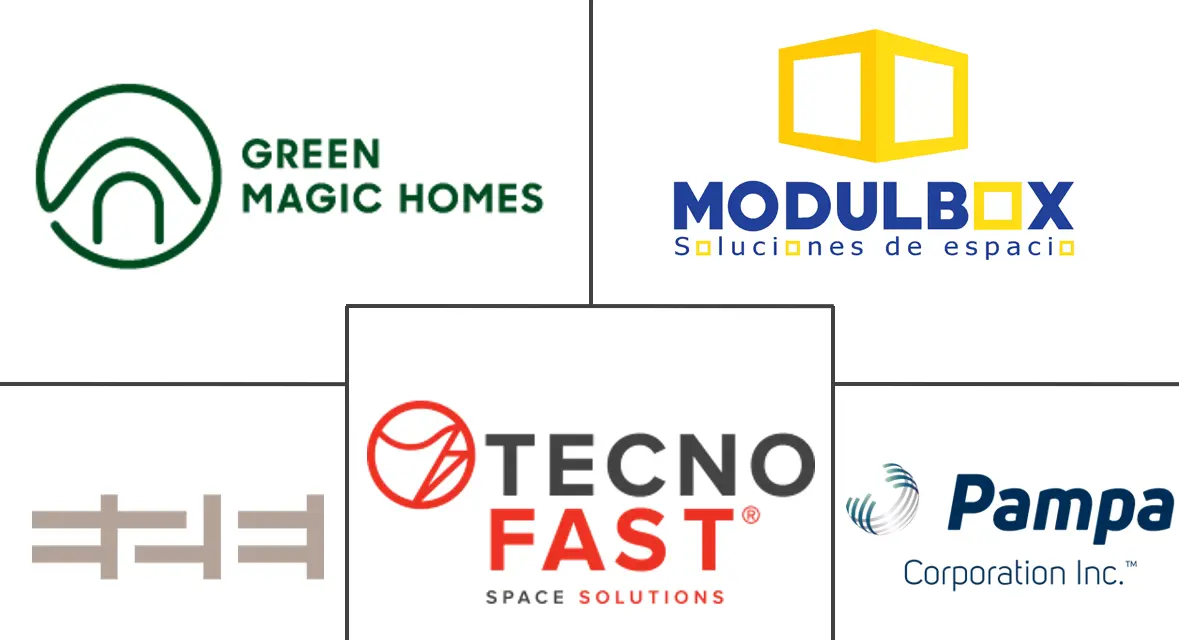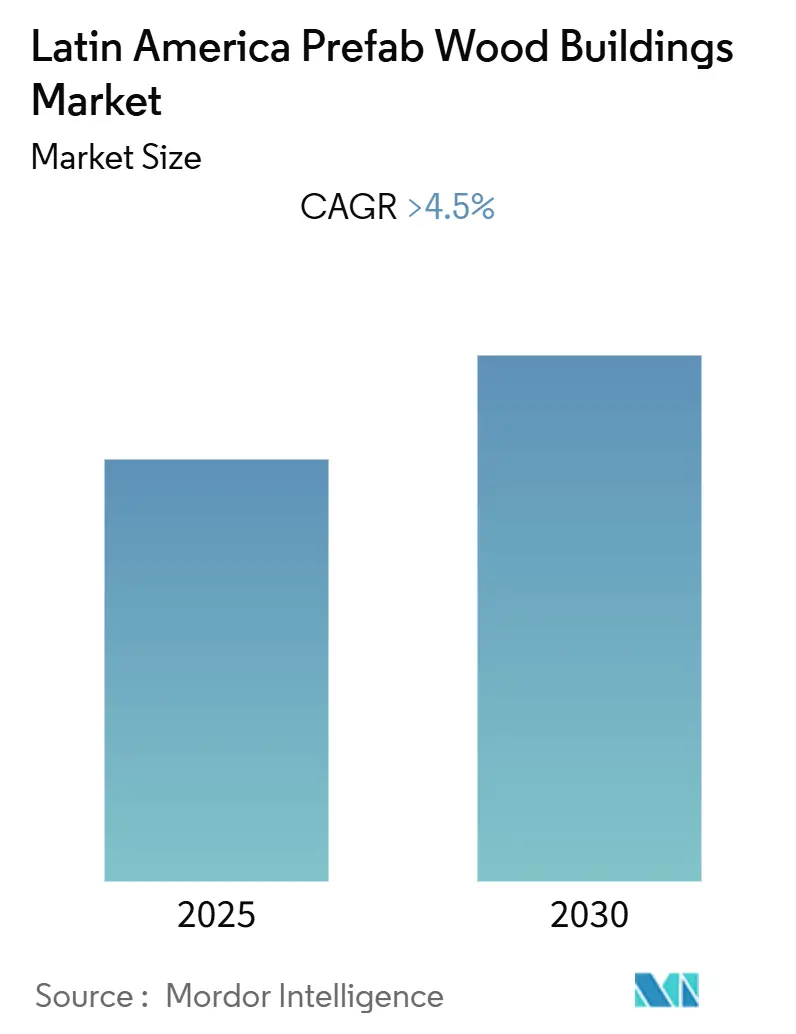
Latin America Prefab Wood Buildings Market Analysis by Mordor Intelligence
The Latin America Prefab Wood Buildings Market is expected to register a CAGR of greater than 4.5% during the forecast period.
- The Latin American prefabricated wood building market has been expanding due to the growing need for affordable housing and sustainable construction practices. Rapid urbanization and population growth in countries such as Brazil and Mexico have been driving the demand for cost-effective and efficient building solutions. Prefabricated wood structures have been recognized for their ability to reduce construction time, lower costs, and provide environmental benefits through the use of renewable materials, making them a preferred choice in the region.
- Government initiatives aimed at promoting green building practices have been playing a significant role in encouraging the adoption of prefabricated wood buildings. Additionally, advancements in prefabrication technologies have been improving the quality and appeal of these structures, further supporting their integration into the construction landscape across Latin America.
- E2E, a joint venture between Celulosa Arauco y Constitución and Belgian company Etex, established its first manufacturing unit for wooden prefabricated housing in Chile. By late 2024, the company had completed 400 two-story houses in Casablanca and two four-story buildings in Concepción. These projects have demonstrated the practicality and scalability of prefabricated wood structures in urban residential developments, showcasing their potential to address housing needs efficiently.
- Technological innovations have been accelerating the growth of the Latin American prefabricated wood building market by enhancing efficiency, precision, and sustainability. Automation and CNC machining have been improving the production quality and speed of wood components, significantly reducing construction timelines. Digital design tools such as BIM (Building Information Modeling) have been optimizing planning and material utilization, minimizing waste and contributing to cost savings.
- Developments in modular assembly and engineered wood products have been expanding the application of prefabricated wood in both residential and commercial projects, making it a versatile solution for diverse construction needs. These advancements have been positioning prefabricated wood buildings as a cost-effective and environmentally sustainable option in the evolving construction market of Latin America.
- The ongoing developments in technology, government support, and urbanization trends have been transforming the Latin American prefabricated wood building market into a dynamic and sustainable segment. With its ability to address housing challenges while promoting eco-friendly practices, the market is expected to play a pivotal role in shaping the region's construction industry in the coming years.
Latin America Prefab Wood Buildings Market Trends and Insights
Residential Growth, Urbanization, and Technological Advancements Driving the Market
The expansion of the residential sector is significantly influencing the growth of the prefab wood buildings market in Latin America. The increasing need for fast, cost-effective, and sustainable housing solutions is driving the adoption of prefabricated wood structures. Urbanization and population growth are accelerating the demand for quicker construction methods, positioning prefab wood as a practical and efficient choice. Technological advancements are improving the durability, efficiency, and design flexibility of these structures, making them more appealing to developers and homeowners. Governments and developers are also emphasizing eco-friendly construction practices, with wood being promoted as a sustainable and renewable material. These factors are collectively transforming the construction landscape in the region and fostering innovation within the prefab wood buildings market.
In October 2024, a team from the University of Biobío in Chile completed Latin America's first 3D-printed concrete home, known as the "seed house." The 30-square-meter structure, constructed in just 29 hours using advanced 3D printing technology, demonstrated the potential for rapid and cost-effective housing solutions. While this development utilized concrete, it underscores the growing focus on innovative construction techniques, which is influencing the evolution of the prefab wood buildings market by encouraging the adoption of advanced technologies and efficient building methods.
The combination of rising residential demand, technological progress, and a shift toward sustainable construction practices is expected to drive further growth in Latin America's prefab wood buildings market. These developments are positioning the market as a key player in addressing the region's housing challenges while promoting environmentally responsible construction solutions.
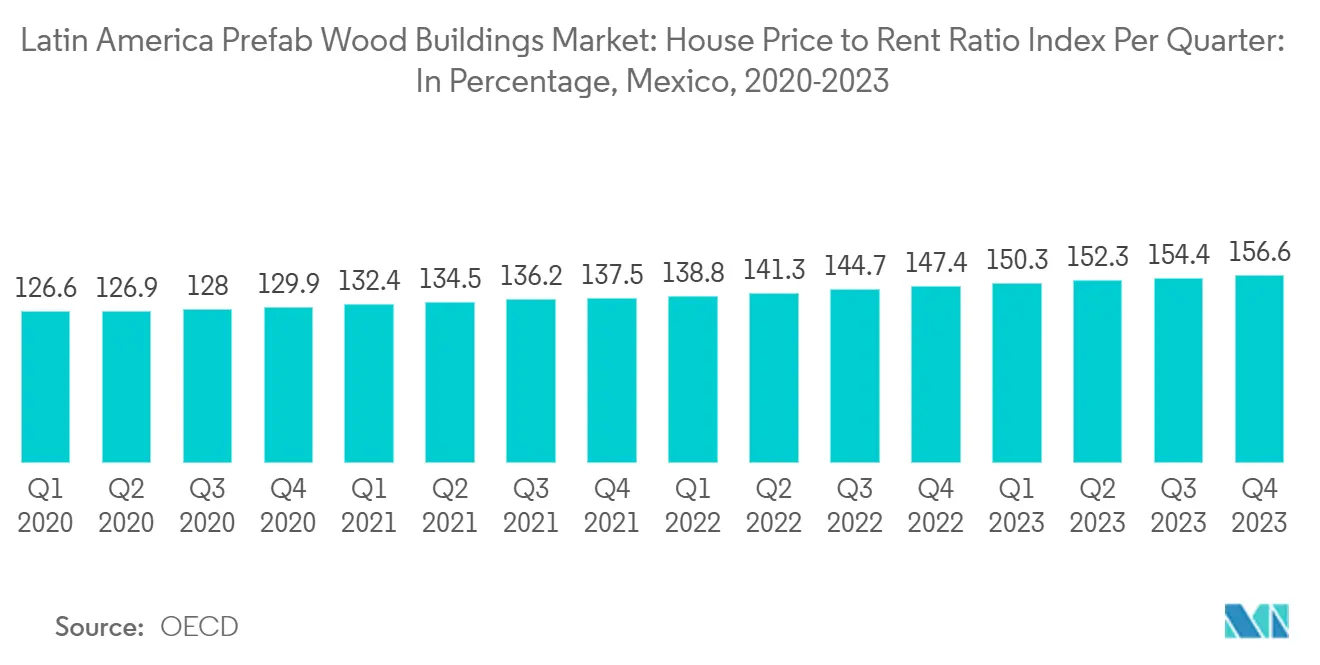
Chile's Construction Advancements Takes the Lead in Market
Chile has become a pivotal player in the Latin American prefabricated buildings market, driven by governmental initiatives, advancements in construction technology, and a focus on sustainable practices. The country's efforts to modernize its construction sector have significantly increased the use of prefabricated methods, particularly in residential and commercial projects, setting a benchmark for the region.
In March 2024, the Chilean government, introduced a plan to construct 260,000 social housing units over four years. This initiative aims to double the nation's housing production while prioritizing industrialized and prefabricated construction techniques to enhance efficiency and quality. Such measures are expected to influence the adoption of similar strategies across Latin America, promoting faster and more sustainable housing solutions.
Additionally, in December 2024, MOLDTECH installed two advanced 3D molds in Chile, significantly boosting the country's modular housing production capabilities. These molds facilitate the efficient production of complete prefabricated concrete structures, enabling scalability and reducing project timelines. This development underscores the growing role of technology in transforming the prefabricated construction landscape in Latin America.
Chile's advancements in prefabricated construction are not only reshaping its domestic market but also setting a precedent for the Latin American region. The focus on industrialized methods and sustainable practices is likely to drive growth in the prefab wood buildings market, positioning Latin America as a competitive player in the global construction industry.
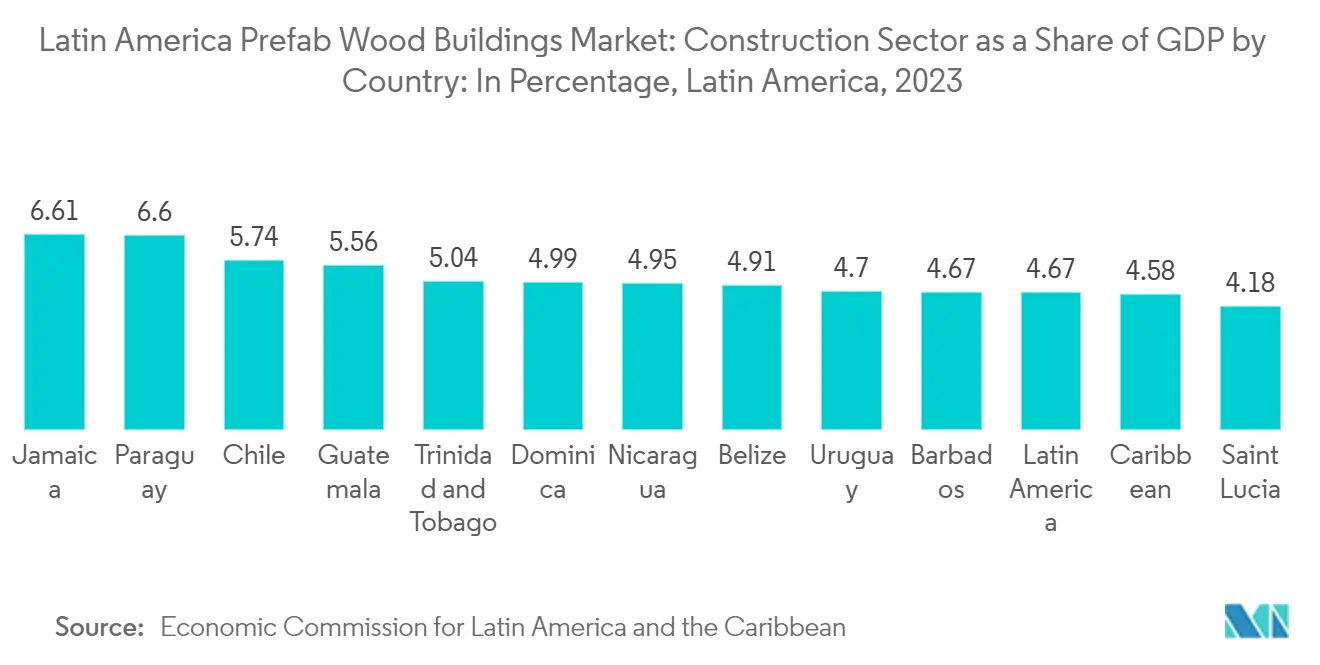
Competitive Landscape
The Latin American prefab wood building market is reported to be fragmented, with numerous companies, including Green Magic Homes, VMD, Modulbox, E2E Chile, and Techno Fast, catering to various segments and regional demands. The market is described as competitive, with no single entity dominating, allowing for regional variations and specialized offerings. This diversity is said to drive innovation and provide consumers with a wide range of prefabricated wood building solutions tailored to local preferences.
Furthermore, The demand for affordable housing drives the prefabricated wood building market in Latin America. Programs like Brazil's "Minha Casa Minha Vida" promote cost-effective and sustainable housing solutions. Prefabrication's speed addresses urbanization challenges, while wood's versatility and appeal enhance its adoption in residential construction.
Latin America Prefab Wood Buildings Industry Leaders
-
Green Magic Homes
-
VMD
-
Modulbox
-
E2E Chile
-
Techno Fast
- *Disclaimer: Major Players sorted in no particular order
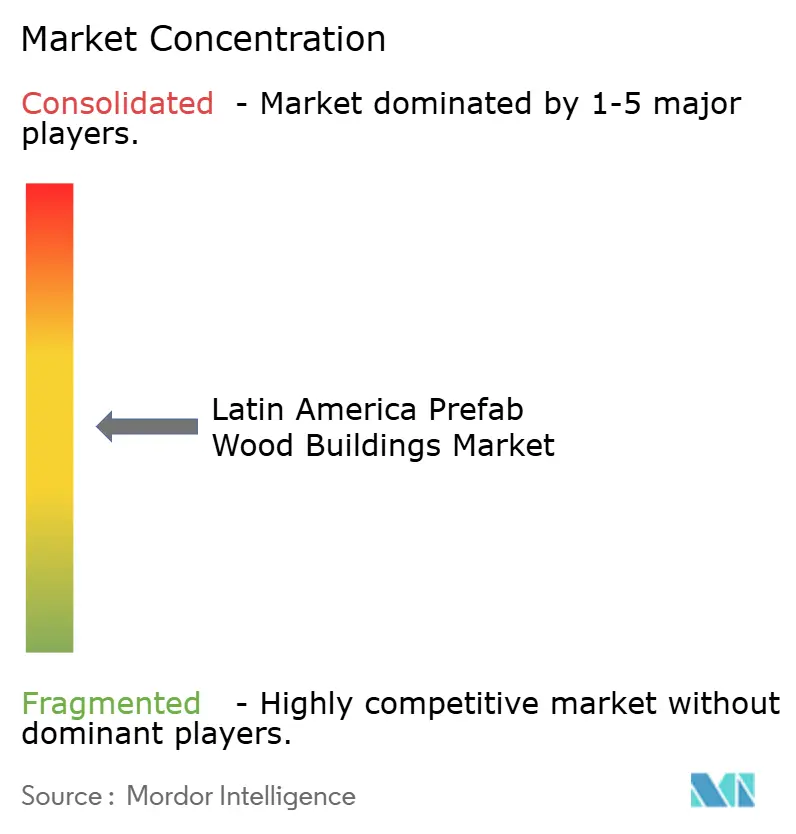
Recent Industry Developments
- September 2024: Valmet reportedly secured a contract to supply a complete pulp mill, including automation and flow control solutions, for Arauco's Sucuriú Project in Brazil. The order, valued at over EUR 1 billion (USD billion), highlights advancements in pulp production technology in Latin America.
- September 2024: Arauco's Board of Directors approved the Sucuriú Project, a new pulp mill in Inocência, Mato Grosso do Sul, Brazil. The project, with an estimated investment of USD 4.6 billion, is expected to become the world's largest single-phase pulp mill, with an annual production capacity of approximately 3.5 million tones of bleached eucalyptus kraft pulp. Operations are projected to begin in the last quarter of 2027, potentially impacting the Latin America prefab wood building market by increasing the availability of raw materials.
Latin America Prefab Wood Buildings Market Report Scope
The prefab wood buildings market encompasses the design, manufacture, and assembly of wooden structures, crafted in factories and then transported for installation. These structures range from residential homes and commercial spaces to modular designs, predominantly utilizing engineered or solid wood. Sustainability trends, cost-effectiveness, and quicker construction timelines fuel the market's growth, outpacing traditional methods. Moreover, technological strides in prefabrication and a rising preference for eco-friendly materials further mold the market landscape. Key industry players span design, manufacturing, and on-site assembly, addressing diverse end-user demands.
The Latin America prefab wood buildings market is segmented by application (residential, commercial, industrial), and by geography (Brazil, Mexico, Argentina, Colombia, Chile, Rest of Latin America). The report offers market size and market forecasts for Latin America prefab wood buildings market in value (USD).
| Cross-Laminated Timber (CLT) Panels |
| Nail-Laminated Timber (NLT) Panels |
| Dowel-Laminated Timber (DLT) Panels |
| Glue-Laminated Timber (GLT) Columns and Beams) |
| Single Family Residential |
| Multi-Family Residential |
| Office |
| Hospitality |
| Brazil |
| Mexico |
| Argentina |
| Colombia |
| Chile |
| Rest of Latin America |
| By Panel Systems | Cross-Laminated Timber (CLT) Panels |
| Nail-Laminated Timber (NLT) Panels | |
| Dowel-Laminated Timber (DLT) Panels | |
| Glue-Laminated Timber (GLT) Columns and Beams) | |
| By Application | Single Family Residential |
| Multi-Family Residential | |
| Office | |
| Hospitality | |
| By Geography | Brazil |
| Mexico | |
| Argentina | |
| Colombia | |
| Chile | |
| Rest of Latin America |
Key Questions Answered in the Report
What is the current Latin America Prefab Wood Buildings Market size?
The Latin America Prefab Wood Buildings Market is projected to register a CAGR of greater than 4.5% during the forecast period (2025-2030)
Who are the key players in Latin America Prefab Wood Buildings Market?
Green Magic Homes, VMD, Modulbox, E2E Chile and Techno Fast are the major companies operating in the Latin America Prefab Wood Buildings Market.
What years does this Latin America Prefab Wood Buildings Market cover?
The report covers the Latin America Prefab Wood Buildings Market historical market size for years: 2019, 2020, 2021, 2022, 2023 and 2024. The report also forecasts the Latin America Prefab Wood Buildings Market size for years: 2025, 2026, 2027, 2028, 2029 and 2030.
Page last updated on:
Latin America Prefab Wood Buildings Market Report
Statistics for the 2025 Latin America Prefab Wood Buildings market share, size and revenue growth rate, created by Mordor Intelligence™ Industry Reports. Latin America Prefab Wood Buildings analysis includes a market forecast outlook for 2025 to 2030 and historical overview. Get a sample of this industry analysis as a free report PDF download.
